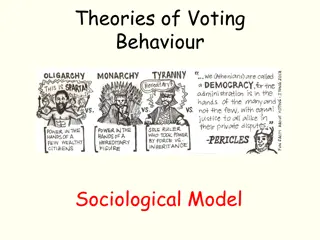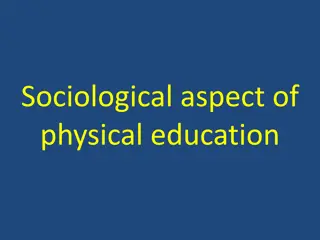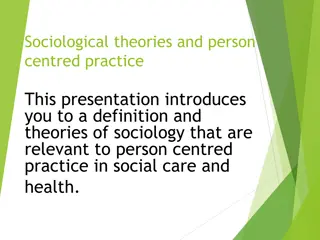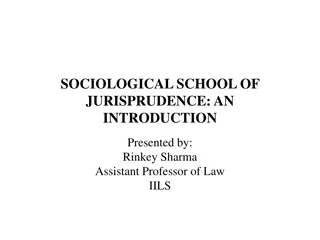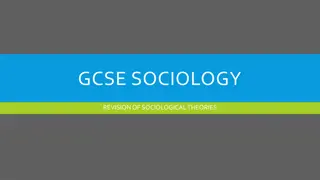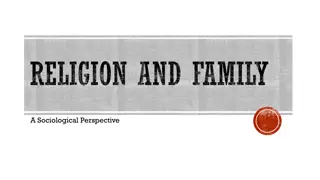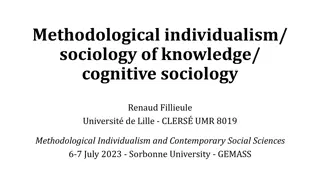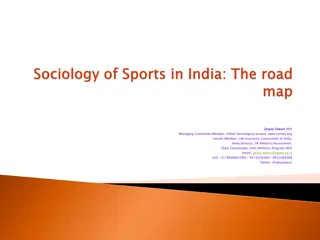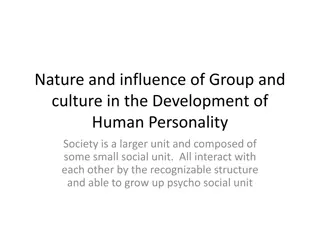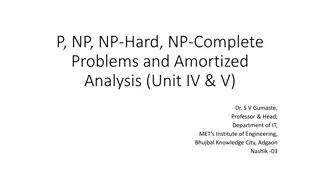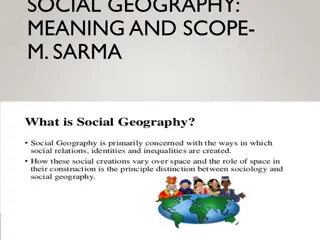Understanding Social Problems: A Sociological Perspective
Social problems are conditions or behaviors that cause public concern and require collective action. Sociology, particularly in the study of social issues, aims to identify both objective elements like measurable harm and subjective elements like moral evaluations. These subjective beliefs can shape society and lead to tangible consequences. By examining these elements, sociologists seek to understand and address societal challenges.
Download Presentation

Please find below an Image/Link to download the presentation.
The content on the website is provided AS IS for your information and personal use only. It may not be sold, licensed, or shared on other websites without obtaining consent from the author. Download presentation by click this link. If you encounter any issues during the download, it is possible that the publisher has removed the file from their server.
E N D
Presentation Transcript
CHAPTER 1 What Are Social Problems?
What Is a Social Problem? A social problem is a social condition or pattern of behaviour that is believed to warrant public concern and collective action. Sociologists have always been concerned about social change and social conflict. The rise of sociology coincided with the rise of modern societies in 19th-century progress: Industrialization and urbanization Inventions and scientific discovery Exposure to new and different ideas and cultures
Sociology and the Study of Social Problems Much of early sociology focused on studying social issues. Early sociologists thought that humanity could direct social change to resolve conflict and rebuild society around new principles of organization.
Objective Elements of Social Problems Objective elements are the measurable features of harmful social condition. e.g., crime, poverty, or alcohol abuse Systematic measurements show that the condition exists and that it harms people. Causes and effects can be studied without making a moral judgment on whether it is serious or trivial. It can count and measure their incidence.
Objective Elements of Social Problems, cont d Can study changes in social life that cause the numbers or rates. Can make and test theories about their changing occurrence. Positivism: a systematic attempt (i.e., scientific approach) to find and test natural laws through measurements of the reality.
Subjective Elements of Social Problems Subjective elements are personal evaluations of objective conditions and the processes that influence their evaluations. This includes the moral labels (e.g., wrong, immoral, sick, etc.) that people apply to particular acts or situations It also includes the accounts people give for these acts and situations. It reflects people s beliefs and tastes.
Subjective Elements of Social Problems, cont d When believed, they become a social reality in their own right. e.g., smoking marijuana is evil, multiculturalism is good, homosexuals are sick, old people are incompetent Such beliefs set in motion actions, actions that have a social consequences (e.g., new legislation or policies). They are harder to measure and to explain.
Objective and Subjective Elements, Together Changes in measurable reality and in our perceptions of measurable reality influence our formulation of social problems. A social problem is both An empirically observed condition that threatens the well- being of a significant part of society, and A process or sequence of events by which members of society come to see a condition as a social problem that warrants collective action.
Social Problems and the Sociological Imagination Sociological imagination (Mills, 1959) is the ability to see connections between one s own life (i.e., micro- events) and the social world in which one lives (i.e., macro-events). Micro-level analysis: focuses on the interactions between individuals in small groups Micro-level analysis: focuses on the societal level social trends occurring within social institutions
Social Problems Research as a Moral Enterprise It aims to change society to protect the vulnerable and amend injustices. It examines the underlying myths, ideologies, and stereotypes that perpetuate harmful conditions: Media often turn public issues into private troubles. Victims are blamed and stigmatized for having these problems. There is a need to examine the underlying causes for these realities.
Social Construction According to social constructionism, a subjective view of reality, not reality itself, shapes one s behaviour. This sociological research approach examines the ways people interact to create a shared social reality. When people define a situation as real, the situation will be real in its effects.
Social Construction, contd Some social problem are simply not real problems. Some individuals will view them as social problems while others do not. But how individuals frame these problems involves a process known as claim-making. Claim-making: A procedure that describes, explains, and blames those involved with the problem labelling them as deviants.
Warnings, Panics, and Claims Whistle-blowers: employees who speak out about an organization s wrongdoings or illegal activities. These employees are often punished. Moral panics: brief yet intense periods of concern. Based on false or exaggerated perceptions. Focused on cultural behaviour or on a particular group of people as dangerously deviant. Results in laws, stereotypes, cultural beliefs, or changed attitudes.
Social Problems: Then and Now 1961, Robert Merton and Robert Nisbet No attention to global inequality No attention to problems related to physical health No attention to the natural environment Sociology has changed in the last 50 or 60 years, and it will continue to evolve.
Theoretical Perspectives on Social Problems Structural functionalism Conflict theory Symbolic interactionism Feminist theory Population health perspective
Structural Functionalism Structural functionalism views society as interconnected elements that work together to preserve stability and efficiency in society. According to Robert Merton (1968), social institutions perform both manifest and latent functions. Manifest functions: the visible and intended goals, consequences, or effects of social structures and institutions. Latent functions: hidden and sometimes unintended consequences of the activities in an organization.
Structural Functionalism, contd Functionalists believe that during periods of rapid change, social disorganization results when institutions fail to do their role. Social disorganization is a reaction to sudden cultural shifts that tend to disrupt traditional values and practices. However, social problems occasionally renew commitment to social boundaries and foster social cohesion.
Structural Functionalism, contd mile Durkheim (1893): Anomie Social norms are weak or come into conflict with one another. As traditional norms and relations break down, social control declines. People feel less tied to each other. Deviant behaviour increases. Need to strengthen social norms and slow the pace of social change.
Conflict Theory Conflict theory rejects the structural functionalist notion of social consensus, and argues that: Conflict and change are basic features of social life, which pits the wealthy privileged and powerful against the poor and powerless. Workers feel alienated unable to change their circumstances. The wealthy use power to maintain their status and power.
Conflict Theory, contd Conflict theorists suggest social problems stem from conflicts: Conflicts are due to the unequal access to limited economic resources leading to conflict and power struggle in society. It has it roots in the historical conflict between the haves and have nots of society. Conflicting individuals and groups/classes routinely struggle for domination over others.
Conflict Theory, contd Karl Marx (1848): posited that industrialized capitalist societies, two broad groups emerge: 1. Bourgeoisie (i.e., the elite owners) of the means of production 2. Proletariat (i.e., the working class) who must sell their labour in exchange for a wage Capitalists use their great economic power and political influence to ensure that they remain in position of dominance over other workers.
Conflict Theory, contd Critics argue many conflicts are not economically based, but related to social injustices, race/ethnicity, gender, and age. Many social conflicts are based on non-class-based interests, values, and beliefs.
Symbolic Interactionism Symbolic interactionism focuses on small-group interactions. Sees society as an abstract unit that s made up of people who interact and share meanings, definitions, and interpretations with one another. Analyzes how people come to frame certain situations as social problems and how people learn to engage in such framing activities.
Symbolic Constructionism Labelling theory: something is a social problem mainly if groups of people define it as such. Howard Becker (1963) argued that people become moral entrepreneurs when they translate their personal beliefs into social rules. Violation of these social rules can lead to labelling as deviant (i.e., wrong).
Symbolic Constructionism, contd Problematic behaviours are socially learned and practised in social settings. Socialization and labelling shape deviant identities and subcultures. Critics argue that social problems may exist even when they are not recognized as problems.
Feminist Theory Feminism focuses on the notion of gender inequality: Feminism is an extension of the conflict theory. Suggests that conflict between men and women is a basic feature of all societies, based on a social system of patriarchy. Women often act out rules defined by men, and women tend to experience the world differently. Men s and women s biological differences do not explain, let alone justify separate social roles, rights, and responsibilities. Instead, gender inequality is a result of socioeconomic and ideological factors.
Feminist Theory, contd Patriarchy: Patriarchy is a form of social organization in which men are the rulers of the household, community, and society. Domination of women and children by adult men. Women s social experience dramatically differs from men. Because of routinely different experiences and differences in power, women and men view the world differently.
Feminist Theory, contd Gendering of experiences Problem of victimization Intersectionality
Post-Modernism and Post-Structuralism Post-modernism: A school of thought that denies the validity of universal, sweeping statements about the world or groups of people within the world, and analyzes the motives behind such statements and the consequences of people believing them Post-structuralism: A concept related to postmodernism that takes analytical deconstruction
Population Health Perspective Population health is a sensitive global measure of how well a society is working. All common social inequalities have significant health consequences. Social problems are revealed by declines in population health. The goal in dealing with social problems is always to avoid and reduce harm.
Population Health Perspective, contd Population health perspective focuses on social problems and harmful health outcomes to the broader population. A broad approach to reducing inadequacies and improving health Determinants of health: Individuals the genetic, hormonal, neurological, and psychological factors that create dysfunctions
Solutions to Social Problems Solutions fall into two main categories: Individual Variations in how people solve problems. Collective Need the cooperation of many people to succeed.
Individual Solutions Solve the problem of exclusion by getting whatever credentials allow you to enter the group you hope to join. Changing the way they think about themselves. Building and using social networks.
Collective Solutions The chief actors in modern society are groups. Ethnic communities Religious groups Professional associations and organizations Multinational corporations Political parties Labour unions Etc. People who work together have a higher chance of affecting change than people who work alone.




